Introduction
Aspidosperma polyneuron is a species that presents serious natural regeneration problems. As a slow-growing tree, it takes almost 50 years to reach its fertile phase, with alternation of blossoming for periods of up to four years, and although it produces abundant seeds, the germination rates are very heterogeneous (35-70%). Furthermore, they are difficult to collect because the trees can reach a height of up to 40 meters in natural conditions. Added to this, the difficult rooting of the cuttings results in the plant propagation of this species not having the expected success (Damasceno et al. 2011; Del Valle, 1972; Ezcurra, et al. 1992; Mozo, 1972; PROEXPO, 1970; Ribas et al. 2005; Sakita et al. 2007; Valeiro et al. 2008).
This species is found in the Red Book of Plants of Colombia under the global and national "Endangered (EN)" category, because its habitat has been severely damaged, as well as the intensive exploitation it has been subject to, resulting in the drastic reduction of its natural populations. In Colombia, entities such as Corporación para la Defensa de la Meseta de Bucaramanga (CDMG) prohibit the use of A. polyneuron and have prohibited its sale in any form. Another entity that oversees the conservation of this species is the National Nature Park System, because it protects the natural populations against any kind of exploitation (Salinas and Cárdenas López, 2007).
Biotechnology is an alternative for the production and improvement of forest species, considering that the production of selected material requires great knowledge of reproductive biology, as well as the physiological mechanisms that influence the morphogenetic capacity, according to Hodson de Jaramillo (2004). Therefore, plant tissue culture is a biotechnological tool that may be a solution to the natural and induced problems that occur in some species.
One of the difficulties for establishing in vitro cultures is the presence of both endogenous and exogenous contaminating microorganisms that affect the viability and development of the explants once they have been established in vitro. Therefore, it is necessary to establish protocols for the minimization or elimination of said microorganisms without affecting the viability of the explants.
The objective of this research was to achieve aseptic establishment and induction of callogenesis in A. polyneuron explants through the evaluation of different disinfection treatments.
Materials and Methods
Collection of plant material: Two sampling areas were established. One is in the North Regional University Campus of the Universidad del Tolima (CUR-NUT, for the Spanish original) in the municipality of Armero-Guayabal in a natural regeneration forest of A. polyneuron, at an altitude of 320 m.a.s.l. and with a temperature of 29.5 °C. The other one is in the Coello Municipality in the Chucualí Jurisdiction, in a plot of land planted with individuals of the species, located at 270 m.a.s.l. and with a temperature of 29 °C. The tissue of young branches without mechanical damage was selected. Apical buds were collected in both areas, and for the CURNUT area, some young seedlings were selected to adapt them to greenhouse conditions and establish them as mother plants.
Laboratory phase: This research was conducted in the facilities of the Laboratory for the Protection of Plants and Plant Tissue Culture of the Universidad del Tolima. Once placed in the greenhouse, the young seedlings were subjected to treatments with 5 g/l benomyl. Treatments were carried out eight days before the explants were taken, and for cases in which there was an attack of insects, insecticide was used. Juvenilization processes were carried out through constant pruning to induce side shoots, from which the explants were taken (apexes, nodal segments and leaf blades).
Preparation of the culture media: The M&S (Murashige & Skoog, 1962) culture medium supplemented with 30 g/l of sucrose as a source of carbon was used for all the disinfection treatments carried out. The pH was adjusted to 5.7 before adding 7 g/l of agar, and 20 ml of the solution were served into glass recipients, duly marked according to the treatments, to later be sterilized in an autoclave for 20 minutes at 121 °C and 15 pounds of pressure.
To induce the formation of calluses, explants of young leaves were taken and cultured in M&S (Murashige & Skoog, 1962) and WPM (Lloyd & McCown, 1980) media with the addition of 30 g/l of sucrose and 7 g/l of agar, and with a pH adjusted to 5.7. The following treatments of plant growth regulators were carried out with 2,4 -D (1 and 2 mg/l) and their respective combinations with BAP (1 mg/l).
The leaf blades were divided into thirds (apex, middle and base), measuring approximately 1 cm2, and each planted in different flasks. The planting was carried out by placing the leaves by the upper epidermis or by the lower epidermis for a total of 16 treatments with 10 replicas. The observations were made for 45 days, during which two subcultures were made. The first after 20 days and the second after 40 days.
All of the resulting treatments were incubated under photoperiod conditions of 12 hours of light at a temperature of 23-25 °C. During the observation period, variables were measured such as coloring (light green or brown), consistency of the callus (friable or compact), and partial or full callus formation.
Disinfection of plant material: Once the explants were selected, they were washed with tap water to remove any particle that could be present. Then, the material was submerged in 100 ml of distilled water with a drop of Tween®80, in constant agitation for ten minutes. Subsequently, they were washed three times with distilled water to remove the detergent, then submerged at different concentrations and exposure times according to the explant in the disinfectant solution. Then, they were washed three times with sterile distilled water in order to remove any trace of disinfectant. On the apexes, 21 disinfection treatments were carried out; on the nodal segments, 19; and on the leaves, 13. Ten replicas were conducted for each disinfection treatment used.
1. Disinfection treatments for apexes: The research was conducted on apical buds selected for their larger size compared to the lateral buds, thus facilitating the extraction of meristems. However, it was observed that when these were completely exposed, they fully oxidized, and so work was conducted on the apexes from which only the most external leaf primordia were removed. Disinfection treatments were carried out with NaClO and another double disinfection treatment with HgCl2.
Table 1 Disinfection treatments used on apexes of A. polyneuron.
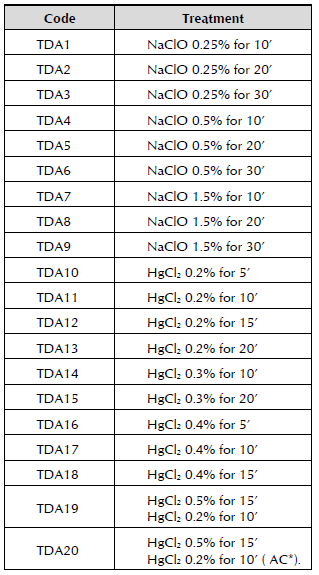
* AC: Activated carbon.
Source: Authors.
3. Disinfection treatment for nodal segments Segments measuring one centimeter long and 3 to 4 millimeters in diameter with a full node were taken. Disinfectant solutions of NaClO and HgCl2 were used in various concentrations and exposure times. Once the disinfection was completed, transversal cuts were made across the base of the explant in order to remove the ends that were observed as affected by the disinfectant. Additionally, the intention was to leave one bud per node in order for the explant to have meristematic tissue suitable for its sprouting. Double disinfection treatments were also carried out on this kind of explant with HgCh. Each treatment was repeated ten times. The proposed treatments can be observed in Table 2.
Table 2 Disinfection treatments used on nodal segments of A. polyneuron.
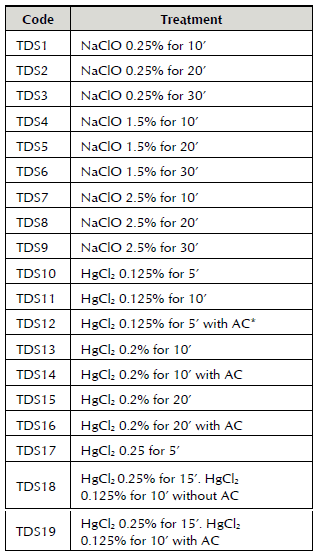
* AC: Activated carbon.
Source: Authors.
4. Disinfection treatments for leaf blades: The leaves closest to the apex were selected to be subjected to the disinfection treatments, which also used solutions of NaClO and HgCl2. Once disinfected and in aseptic conditions, the leaves were cut all the way down the margin in order to remove the tissue that could have become necrotic after disinfection. The treatments are summarized in Table 3.
Table 3 Disinfection treatments used on leaf explants of A. polyneuron.
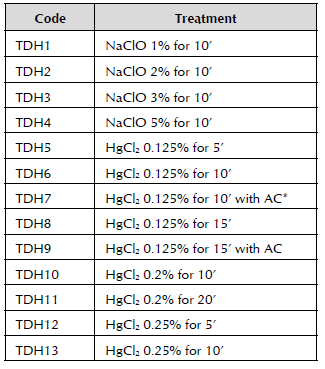
* AC: Activated carbon.
Source: Authors.
Once inoculated in the M&S culture medium, they were incubated under a photoperiod of 12 hours of light (1000 lux fluorescent lamps) at a temperature of 23-25 °C for three weeks. At the end of which, the number of explants contaminated by fungi and/or bacteria was determined through daily observations during the first days after planting, then weekly. The number of oxidized explants was also established through weekly observations. Finally, the number of healthy and viable explants was determined.
Statistical stage: In this stage, the results were analyzed using factor analysis of multiple correspondence through the perceptual mapping tool. The information was processed with the multivariate statistical software SPAD 4.5. Correspondence analysis is an exploratory statistical method that is applied based on the analysis of contingency tables that reflect perceptual maps comprised of two main factors: F1 over the X axis, which absorbs greater information on variability with respect to the original treatments, which are closer to the point of inertia or origin (average); and F2 over the Y axis, which is the second factor on the uptake scale of information about the rest of the original treatments. Said graph collectively shows the different categories of the contingency table (1 was contaminated, 2 was not contaminated and 3 was oxidized) so that the proximity between the points represented by these categories reflects a level of association between them, and furthermore, the ones closer to the point of origin are those most characterized based on the context.
Results and Discussion
In the assessment of contamination, it was observed that in the three proposed explants, the highest percentages of contamination were found when the disinfectant agent was NaClO. Losses in the majority of cases of up to 100% of the samples were mainly due to the appearance of fungi. When working with field material, this is one of the main factors that affects the establishment of explants (Abdelnour et al. 2011).
As can be observed, in Figure 1, the perceptual map for the disinfection of apexes of A. polyneuron, the treatments closest to the point of inertia are those that used NaClO, but these did not control contamination 100%, and so they were called "contaminated". Therefore, it is confirmed that this disinfectant was inefficient for the control of contamination. The treatments with HgCl2 are more distant, although they did not control contamination either. In light of these tests with limited success, double disinfection treatments with HgCl2 were used, which are observed as very close to the origin. However, the TDA19 and TDA20 treatments presented around 80% oxidation of the explants. Just the treatments with 0.3% HgCl2 for ten minutes and with 0.1% HgCl2 for one minute (TDA21) were effective, because their "not contaminated" response is found close to the point of inertia with contamination control of 80 to 100%. Additionally, this treatment did not present problems of oxidation, which translates into the best disinfection treatment used on apexes of A. polyneuron.
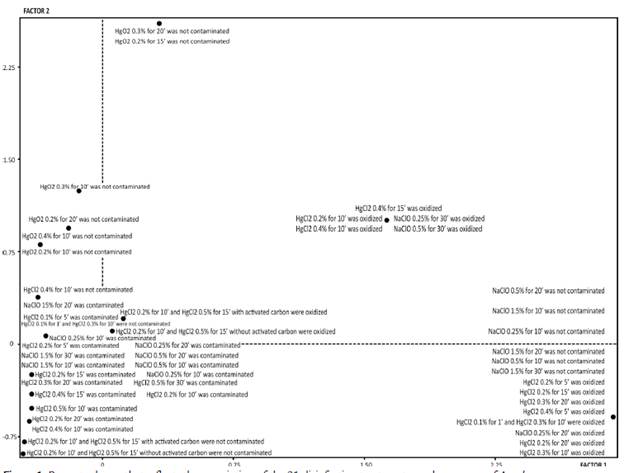
Source: Authors.
Figure 1 Perceptual map that reflects the association of the 21 disinfection treatments used on apexes of A. polyneuron.
HgCl2 continues to be successfully used as a disinfectant solution on many forest and firewood species with serious problems of contamination, as mentioned by Zibbu and Batra (2010).
The physiological age of the tissue used to initiate the establishment of the cultures also has great influence on the disinfection process. This is because the material taken from the growing plants is easier to disinfect compared to the material obtained from mature plants, where the wax and lignin deposits are greater, which in turn become a barrier for the action of the disinfectant agent on the endogenous microorganisms (López et al. 2010; Pedroza et al. 2007; Toro, 2004).
According to Abdelwahd et al. (2008) and Pedroza et al. (2007), obtaining explants to start in vitro culture activities necessarily causes cuts or wounds in the tissue. These facilitate the entry of nutrients and plant hormones, but also facilitate the exudation of compounds related to scarring and defense against external agents (mainly pathogens). These compounds, which generally have a phenolic structure, are rapidly oxidized, causing darkening of the culture medium and of the tissue, resulting in their necrosis and death.
The graph also shows that in all the disinfection treatments used, oxidation was low (less than 20%), and the graph points for this category are far away from the origin, with the exception of the TDA19 and TDA20 treatments, in which this phenomenon predominated.
Figure 2 shows the perceptual map for the disinfection treatments used on nodal segments. Those treatments that presented contamination and oxidation (values over 70%) are located close to the origin. The treatments with NaCIO presented more contamination compared to those in which HgCl2 was used, but oxidation was more frequent in this one. However, Seneviratne and Wijesekara (1996) found that different concentrations of sodium hypochlorite promoted the darkening of shoots of Hevea brasiliensis more than mercury(II) chloride.
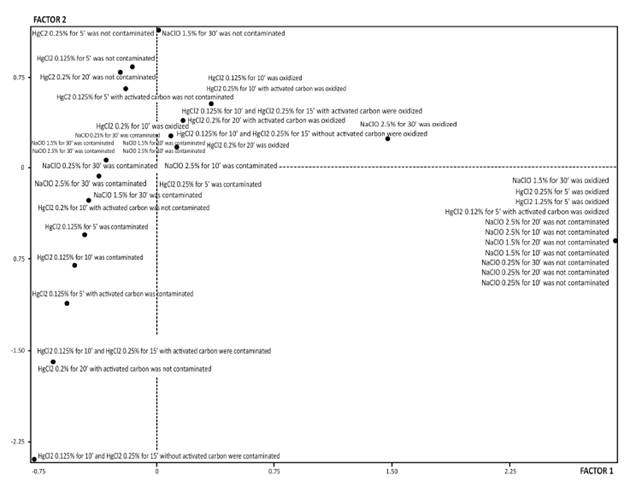
Source: Authors.
Figure 2 Perceptual map that reflects the association of the disinfection treatments used on nodal segments of A. polyneuron.
The graph also indicates two treatments with HgCl2 close to the point of inertia in which disinfection was more than 80%. These were the treatments 0.125% HgCl2 for five minutes and 0.2% HgCl2 for ten minutes, both in the presence of activated carbon (TDS12 and TDS14, respectively). However, in the latter, the value of its contribution to the "oxidized" category is less than the value obtained in the TDH12 treatment, as can be observed in Table 4.
Table 4 Value of the contributions for the TDS12 and TDS14 treatments in the "not contaminated" and "oxidized" categories, and their respective percentages of contamination and oxidation.

Source: Authors.
As can be observed in the previous table, the TDS14 treatment is more effective in controlling contamination because it is closer to the origin. However, oxidation is much higher (60%) than in the TDS12 treatment (10%), which despite having a higher rate of contamination, has a lower number of necrotic explants.
In their review, Dobránszki & Teixeira (2010) state how effective it is to initially supplement the culture medium with activated carbon to prevent the darkening of the explants, because this provides a dark environment and inactivates the peroxidases and polyphenol oxidases, which translates into an increase in surviving material. This could be demonstrated in the work when 3 g/l of activated carbon were added to the culture medium, which considerably reduced the oxidation and subsequent death of the explants. Therefore, it is recommended to disinfect the nodal segments of A. polyneuron with HgCl2 at a concentration of 0.125% for five minutes and to supplement the culture medium with activated carbon.
In the leaf blade explant, no double disinfection treatments were required, and the concentrations and exposure times to mercury(II) chloride were some of the lowest. Therefore, it is concluded that the leaves positively respond to the disinfection treatments, minimizing the effects of oxidation and microbial contamination.
In Figure 3, the perceptual map shows the relationship of the disinfection treatments used in leaf blades of A. polyneuron, which presents a different composition to those previously obtained, because a clearer map is shown, as large groupings around the origin are not recorded. Therefore, it reflects that contamination and oxidation were not so evident in the leaves as in the other evaluated explants.
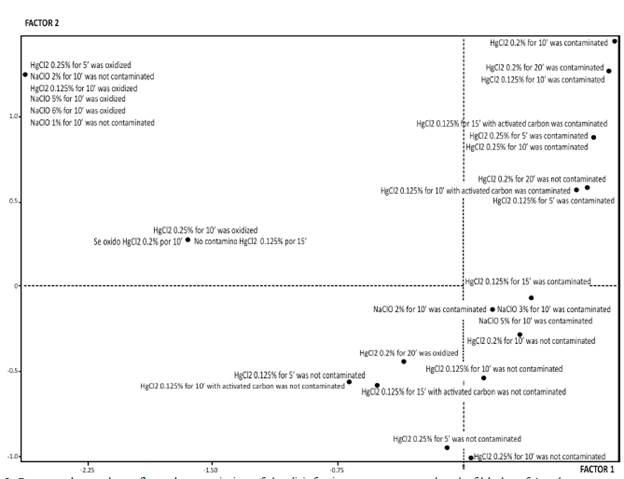
Source: Authors.
Figure 3 Perceptual map that reflects the association of the disinfection treatments used on leaf blades of A. polyneuron.
The map confirms again the results of the other explants, where the highest rates (more than 80%) of disinfection and oxidation were observed when the disinfectant was mercury(II) chloride. However, NaClO works better than the other disinfectants, as studied by Montes (2004), who compared the use of NaClO in leaves of Anthurium andreanum with CaClO.
It is also observed that the two treatments in which mercury(II) chloride was used are the closest ones to the origin in the "not contaminated" category: HgCl2 at 0.125% for ten minutes (TDH6) and HgCl2 at 0.2% for ten minutes (TDH10). However, the latter showed greater oxidation, which is recognized in the perceptual map, located at a closer point to the origin.
As shown in Table 5, the TDH10 treatment is more effective in controlling the contamination of leaf blades. However, oxidation increases, which is lower in the TDH6 treatment, where this phenomenon is not so evident.
Table 5 Value of the contributions for the factors F1 and F2 in the "not contaminated" and "oxidized" categories for the TDH6 and TDH10 treatments, and their respective percentages of contamination and oxidation.

Source: Authors.
In agreement with that stated by Torres et al. (1998) cited by Alves Dos Santos et al. (2010), effective disinfection is one in which the explants that have been exposed to a low concentration of disinfectant present reduced rates of microbial contamination and oxidation. The TDH10 and TDH6 treatments presented very similar results, but TDH6 is chosen for subsequent disinfection tests on leaf blades of A. polyneuron, because it presents a lower concentration of HgCl2 and produces less oxidation in the explants, which ultimately translate into less possibility of damage to the explant, such as burns, toxicity or lack of vigor.
Table 6 summarizes the contributions for the "contaminated", "not contaminated" and "oxidized" categories for the best treatments used in the three kinds of explant evaluated.
Table 6 Value of the contributions for the "contaminated", "not contaminated" and "oxidized" categories for the treatments TDA21, TDS12 and TDH6.

Source: Authors.
* Disinfection treatment used on apexes.
** Disinfection treatment used on nodal segments.
*** Disinfection treatment used on leaf blades.
As observed in the previous table, the explant that responded the best to the proposed disinfection treatments was that of the apexes, because there were no contaminated replicas. This is followed by the leaves and lastly, by the nodal segments, which was the type of explant that presented the most problems in the disinfection process. In terms of the oxidation processes, the three types of explant used in the study presented the same percentage (10%), which is considered to be low and not limiting for the establishment of the culture.
If it is taken into account that compared to the other two kinds of explant, the leaf blade presented moderate contamination, the lowest oxidation and the greatest callus production, which was sought as a positive result to continue the process of indirect embryogenesis in A. polyneuron, the leaf blade proves to be the ideal explant.
Mercury(II) chloride was more efficient than sodium hypochlorite in controlling contamination in explants of A. polyneuron; results which coincide with those found by Ribas et al. (2003). However, this is a very toxic product, which is active at low concentrations, presents a carcinogenic action, and mainly affects the mammary glands and the female reproductive system, as well as damage to the central nervous system. It may cause burns when it comes into contact with the skin and it is corrosive to the eyes. It can also cause serious problems in the respiratory system if the product is inhaled (Smith, 2013). It is recommended to prevent its elimination by drainage, because this compound bioaccumulates throughout the food chain and has prolonged effects on the environment.
Conclusions
The explant selected for its capacity to produce friable and green-colored calluses was the leaf blade, for which disinfection with mercury(II) chloride (HgCl2) at 0.125% for ten minutes was sufficient to control contamination and presented low rates of oxidation.
In the event that the shoot apex is used as the explant, double disinfection must be used, as follows. Once taken from the mother plant, the complete buds need to be submerged in HgCl2 at 0.3% for ten minutes, and after the removal of the perulae and most external leaf primordia, in HgCl2 at 0.1% for one minute.











 text in
text in 


